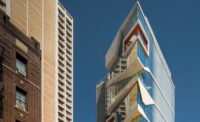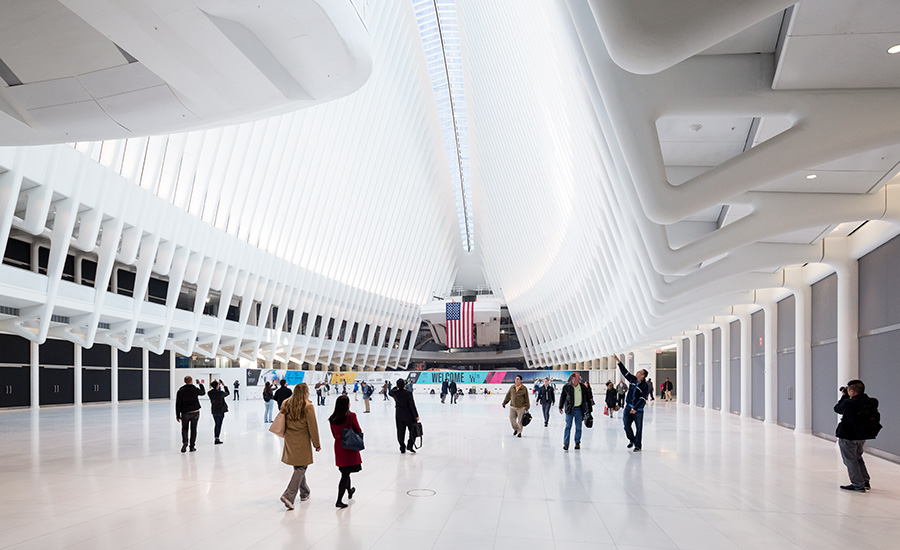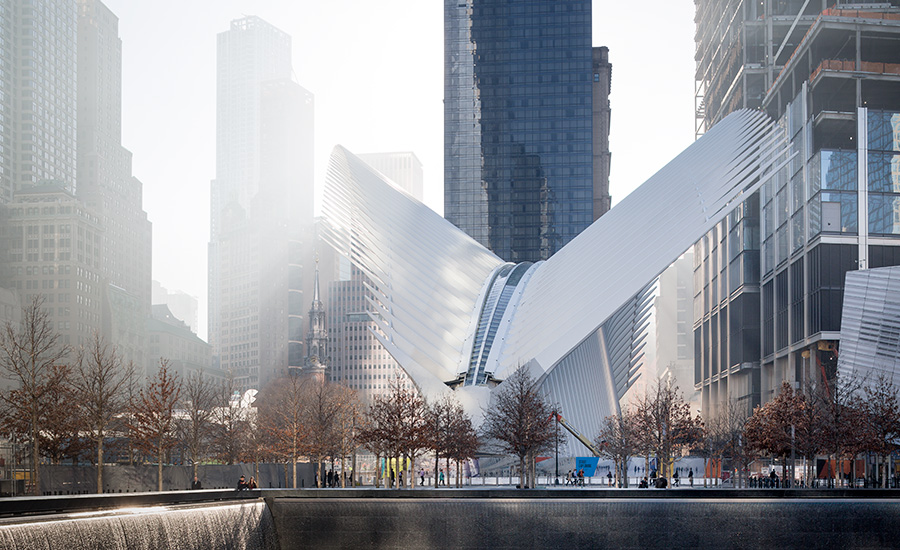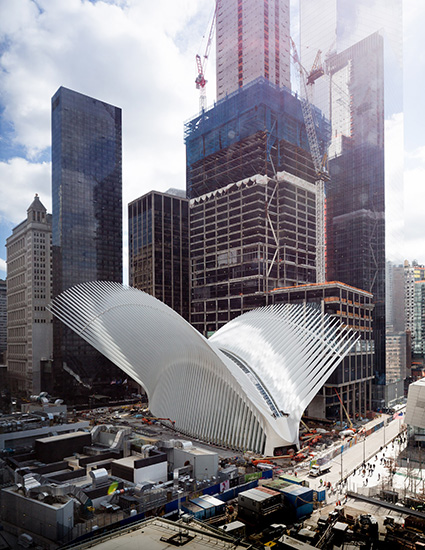World Trade Center Transportation Hub by Santiago Calatrava
After more than a decade of construction, the Oculus at the World Trade Center in New York City finally opens.

World Trade Center Transportation Hub
The elliptical and cathedral-like Oculus, which has a 330-foot-long skylight, is supported by gleaming white steel ribs that soar 160 feet. Retail spaces, which ring the hall’s perimeter on two levels, have been fully leased but are not yet open.
Photo © James Ewing

World Trade Center Transportation Hub
The hub has a tight site between Rogers Stirk Harbour + Partners’ 3 WTC tower rising to the south and Bjarke Ingels’s 2 WTC planned for the lot just to the north.
Photo © James Ewing

World Trade Center Transportation Hub
The hub has a tight site between Rogers Stirk Harbour + Partners’ 3 WTC tower rising to the south and Bjarke Ingels’s 2 WTC planned for the lot just to the north.
Photo © James Ewing

World Trade Center Transportation Hub
The Oculus ribs cantilever to suggest the outstretched wings of a bird.
Photo © James Ewing

World Trade Center Transportation Hub
The Oculus skylight is operable. It will be opened each year on September 11th.
Photo © James Ewing

World Trade Center Transportation Hub
The Oculus skylight is operable. It will be opened each year on September 11th.
Photo: © James Ewing

World Trade Center Transportation Hub
An underground passage leading west employs an architectural language similar to that of the Oculus, with bonelike steel structural elements.
Photo © James Ewing







Architects & Firms
Early last month, Santiago Calatrava’s World Trade Center Transportation Hub in New York finally made its public debut. But after more than a decade of construction, little fanfare marked the milestone for the much-delayed, nearly $4 billion project, which was originally slated to open in 2009 and was first estimated to cost $2.2 billion. Instead, the client, the Port Authority of New York & New Jersey, removed some of the construction barriers, giving people access to one of several street-level entry points and one end of the almost-complete main hall. The space, known as the Oculus, is the centerpiece of a sprawling network of underground connections among the World Trade Center’s office towers and a station for the PATH train to New Jersey, which the agency says will serve 100,000 commuters per day.
The hub is expected to be more complete later this spring, when some of its 365,000 square feet of retail space is fit out and a 350-foot-long pedestrian tunnel running east will open, linking the World Trade Center (WTC) with the Fulton Center and its 11 subway lines. As an explanation for the ballooning price tag and the delays, the Port Authority says that the hub’s initial budget and timetable were set even before the design was complete. But other factors contributed, as numerous news outlets have reported. One example: a subway line that runs through the site had to remain operating throughout the course of the project. Another was a mandate that the 9/11 Memorial Museum be completed in time for the 10th anniversary of the terrorist attacks. That meant that the memorial plaza, which is part of the hub’s roof, had to be built before the station below it, complicating construction on the already congested and challenging site.
But putting the debate about cost and schedule aside, even in its not-quite-finished state, the Oculus’s interior should wow people who pass through the elliptical, cathedral-like space. Its gleaming white steel ribs soar 160 feet, and during daylight hours the sun streams between the bone-shaped structural elements and down from a 330-footlong central skylight, making it hard to believe that the pristine white marble floor sits two stories below the street.
One part of the hub that is more fully functional is an underground concourse leading west to the former World Financial Center (now Brookfield Place), open since late 2013. The pedestrian passageway relies on a language similar to that of the Oculus, with white marble floors and walls and arched steel elements that provide the 460-foot-long, doublestory passageway with a graceful rhythm. Its electric illumination, which bounces light off the ceiling, emphasizes the structural components and gives the whole space an inviting, almost ethereal, glow.
Unfortunately, this subterranean drama doesn’t translate into coherence above grade. Outside, the Oculus ribs transform into outstretched wings that in Calatrava’s first schemes pivoted to open the glazed skylight. Although the operable skylight survived value engineering, the movable wings did not. But kinetic or fixed, these elements are too literal—intended to suggest a flying dove. And the building, which has been likened to everything from a stegosaurus to a porcupine to a Thanksgiving turkey carcass, is ill at ease on its site. Not only is its biomorphic form at odds with the fiercely rectilinear geometry of its surroundings, but the spiky creature is hemmed in with little breathing room—wedged between Rogers Stirk Harbour + Partners’ 3 World Trade Center rising just to the south and Bjarke Ingels’s 2 WTC planned for the plot to the north. Its asymmetrical wings seem almost to have been clipped to fit the building onto its site. From the outside, the Oculus reads more like a beached whale than a bird about to take flight.
This aboveground idiosyncratic expression may be forgiven, however, if the Oculus’s interior is used as Calatrava envisioned it. He has referred to it as a “piazza for New York,” where people will gather or sit with a cup of coffee, in addition to circulating through on their way to the train. Yet with so little of it accessible, and with none of the retail that will ring its perimeter open, it is hard to know if commercial activity will compete with or complement his grand civic gesture.
Time-Lapse Courtesy of EarthCam











